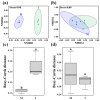Intercropping with Potato-Onion Enhanced the Soil Microbial Diversity of Tomato
- PMID: 32498315
- PMCID: PMC7357159
- DOI: 10.3390/microorganisms8060834
Intercropping with Potato-Onion Enhanced the Soil Microbial Diversity of Tomato
Abstract
Intercropping can achieve sustainable agricultural development by increasing plant diversity. In this study, we investigated the effects of tomato monoculture and tomato/potato-onion intercropping systems on tomato seedling growth and changes of soil microbial communities in greenhouse conditions. Results showed that the intercropping with potato-onion increased tomato seedling biomass. Compared with monoculture system, the alpha diversity of soil bacterial and fungal communities, beta diversity and abundance of bacterial community were increased in the intercropping system. Nevertheless, the beta-diversity and abundance of fungal community had no difference between the intercropping and monoculture systems. The relative abundances of some taxa (i.e., Acidobacteria-Subgroup-6, Arthrobacter, Bacillus, Pseudomonas) and several OTUs with the potential to promote plant growth were increased, while the relative abundances of some potential plant pathogens (i.e., Cladosporium) were decreased in the intercropping system. Redundancy analysis indicated that bacterial community structure was significantly influenced by soil organic carbon and pH, the fungal community structure was related to changes in soil organic carbon and available phosphorus. Overall, our results suggested that the tomato/potato-onion intercropping system altered soil microbial communities and improved the soil environment, which may be the main factor in promoting tomato growth.
Keywords: Illumina MiSeq sequencing; intercropping; potato-onion; soil microbial community; tomato.
Conflict of interest statement
The authors declare no conflict of interest.
Figures







Similar articles
-
Potato-onion intercropping enhances tomato yield and quality and modifies soil microbial diversity.Sci Rep. 2025 Aug 20;15(1):30573. doi: 10.1038/s41598-025-15045-1. Sci Rep. 2025. PMID: 40835993 Free PMC article.
-
Biochar and Intercropping With Potato-Onion Enhanced the Growth and Yield Advantages of Tomato by Regulating the Soil Properties, Nutrient Uptake, and Soil Microbial Community.Front Microbiol. 2021 Aug 27;12:695447. doi: 10.3389/fmicb.2021.695447. eCollection 2021. Front Microbiol. 2021. PMID: 34512573 Free PMC article.
-
Effects of Intercropping with Potato Onion on the Growth of Tomato and Rhizosphere Alkaline Phosphatase Genes Diversity.Front Plant Sci. 2016 Jun 15;7:846. doi: 10.3389/fpls.2016.00846. eCollection 2016. Front Plant Sci. 2016. PMID: 27379133 Free PMC article.
-
Root separation modulates AMF diversity and composition in tomato-potato onion intercropping systems.Front Microbiol. 2025 Mar 12;16:1554644. doi: 10.3389/fmicb.2025.1554644. eCollection 2025. Front Microbiol. 2025. PMID: 40143864 Free PMC article.
-
Plant-Derived Protectants in Combating Soil-Borne Fungal Infections in Tomato and Chilli.J Fungi (Basel). 2022 Feb 21;8(2):213. doi: 10.3390/jof8020213. J Fungi (Basel). 2022. PMID: 35205967 Free PMC article. Review.
Cited by
-
Three Preceding Crops Increased the Yield of and Inhibited Clubroot Disease in Continuously Monocropped Chinese Cabbage by Regulating the Soil Properties and Rhizosphere Microbial Community.Microorganisms. 2022 Apr 10;10(4):799. doi: 10.3390/microorganisms10040799. Microorganisms. 2022. PMID: 35456849 Free PMC article.
-
Impact of Sugarcane-Pumpkin Intercropping on Soil Microbial Diversity.Microorganisms. 2025 Jul 20;13(7):1703. doi: 10.3390/microorganisms13071703. Microorganisms. 2025. PMID: 40732212 Free PMC article.
-
Response of soil microecology to different cropping practice under Bupleurum chinense cultivation.BMC Microbiol. 2022 Sep 22;22(1):223. doi: 10.1186/s12866-022-02638-3. BMC Microbiol. 2022. PMID: 36138372 Free PMC article.
-
Intercropping grapevine with Solanum nigrum enhances their cadmium tolerance through changing rhizosphere soil microbial diversity.Front Microbiol. 2025 Mar 7;16:1537123. doi: 10.3389/fmicb.2025.1537123. eCollection 2025. Front Microbiol. 2025. PMID: 40124892 Free PMC article.
-
Effects of different rotation cropping systems on potato yield, rhizosphere microbial community and soil biochemical properties.Front Plant Sci. 2022 Sep 29;13:999730. doi: 10.3389/fpls.2022.999730. eCollection 2022. Front Plant Sci. 2022. PMID: 36247636 Free PMC article.
References
-
- Lithourgidis A.S., Dordas C.A., Damalas C.A., Vlachostergios D.N. Annual intercrops: An alternative pathway for sustainable agriculture. Aust. J. Crop Sci. 2011;5:396–410.
-
- Nyawade S., Karanja N., Gachene C., Gitari H., Parker M.L. Short-term dynamics of soil organic matter fractions and microbial activity in smallholder potato-legume intercropping systems. Appl. Soil Ecol. 2019;142:123–135. doi: 10.1016/j.apsoil.2019.04.015. - DOI
-
- Acosta-Martínez V., Dowd S., Sun Y., Allen V. Tag-encoded pyrosequencing analysis of bacterial diversity in a single soil type as affected by management and land use. Soil Biol. Biochem. 2008;40:2762–2770. doi: 10.1016/j.soilbio.2008.07.022. - DOI
Grants and funding
LinkOut - more resources
Full Text Sources

